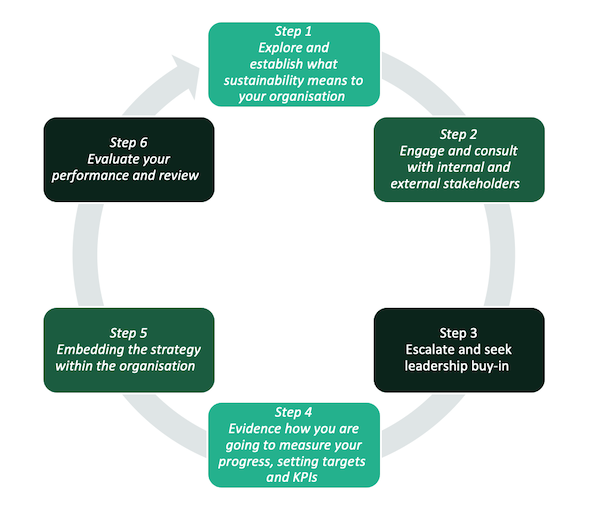Getting a sustainability strategy right is crucial; it is the ability to sustain your business into the future. Sustainable companies have better returns on assets (34%) and equity (16%)[I]. They have better operational (88%) and investment (80%) performance[II]. Firms with a better sustainability record have produced higher returns for investors and are less likely to suffer from large share price declines[III]. It’s valued by customers too, nearly eight in 10 consumers indicate sustainability is important and some will even pay a premium for it[IV]. OK, message received, we need a strategy, but how do you go about it?

Step 1 – Explore and establish what sustainability means to your organisation
Take a good look at your organisation’s values, its mission and vision for the future, this will help you identify what sustainability risks and opportunities are relevant to your business. When considering these keep an eye on both the short and long term. Utilise the United Nations Sustainable Development Goals[V] to help you identify the most significant and those that will have the biggest impact.
Research from McKinsey identified that organisations who build sustainability into their operations saw immediate benefits[VI], connecting the business benefits creates value and lessens risks.
Step 2 – Engage and consult with internal and external stakeholders
We all know that stakeholders can make or break any project. A good framework to use for consultation is a materiality assessment, the process of identifying, refining and assessing potential social and environmental topics that could affect your business and or stakeholders[VII]. This process will help you to prioritise the areas of focus you have uncovered in Step 1. The output is often a matrix which has two dimensions, the importance to stakeholders and the impact on the business. Presenting the results in this way helps to narrow the output down to the three to five priorities that are the sweet spot for an achievable strategy.
Whatever tools you choose to use, engaging with stakeholders can be achieved through a range of channels including interviews, workshops or surveys.
The benefits of this stakeholder engagement are compelling, co-creating the sustainability strategy with staff for example builds partnership and trust, fostering legitimacy and acceptance[VIII]. Employees are more engaged when they help shape the company’s future, leading to 21% greater profitability[IX]. While you it may feel natural to begin with internal groups, it is important you consider external stakeholders such as suppliers, NGOs, local community, and customers at this stage.
Step 3 – Escalate and seek leadership buy-in
Senior management buy-in is key. Without it the strategy won’t get off the ground, let alone be effective. Key to achieving this is building the business case for sustainability and sharing the results of the stakeholder consultations. Let them know what people who are important to the business are thinking. Make sure you are engaging with the different business units to ensure the strategy aligns with the different parts of the organisation[X] and what its impact would be if they maintained business as usual and ignored the risks and opportunities. Case studies, competitor benchmarking and innovation work well in building a compelling argument. Above all remind them once again of that business case, the true meaning of a sustainable business is one that lasts.
Step 4 – Evidence how you are going to measure your progress, setting targets and KPIs
Take the priorities identified in Step 2 and for each identify targets and KPIs. This is going to be how you will be tracking your progress over time. Targets should be:
- Specific to the priority
- Measurable through data or evidence
- Ambitious enough to motivate staff
- Relevant to the business strategy
- Time-oriented to increase the likelihood of being able to track them over time.
Step 5 – Embedding the strategy within the organisation
To be embedded into the business successfully it is important that the sustainability strategy is seen as a way for the organisation to fulfil its purpose, this will make staff feel accountable and showcases sustainability as a priority for the business. Every member of staff should have the information available to understand what this strategy means for them in their particular role. Recent research from McKinsey identified that the main reason for a company’s failure to capture the full value of sustainability is the lack of incentives [XI].
A communications plan is crucial to help ensure staff are informed and engaged in your sustainability strategy. Remember that communications should not be one way, consider creating a taskforce of volunteers which provides staff with the opportunity to be sustainability champions, able to feedback throughout and contribute to the achievement of targets.
Having visible targets which are easily accessible and regularly updated will help engage and motivate individuals. Better still is making a public commitment and publishing regularly progress against targets solidifies the importance of sustainability to the organisation.
Step 6 – Evaluate your performance and review
Make sure your reporting is structured, consistent and delivered on a published schedule. Pull out key points to allow busy stakeholders to hone in on the important aspects without trawling through fifty charts or tables. As well as keeping it simple, keep it honest. Champion successes and pinpoint areas for development not forgetting to identify ways of addressing them.
Don’t measure for the sake of it. Make sure every measurement has a purpose whether it is a motivational one keeping stakeholders informed and encouraged or providing key datapoints you can act upon to make adjustments to the strategy.
Remember a meaningful sustainability strategy is not simply ticking the boxes it is about creating a sustainable way forward for the organisation that is supported across the board and can be effectively and consistently implemented throughout the long term. Don’t be daunted, with those six steps you can do it.
Referencing
[II] https://papers.ssrn.com/sol3/papers.cfm?abstract_id=2508281
[III] https://www.weforum.org/agenda/2020/01/sustainability-profitability-co-exist/
[IV] https://www.ibm.com/downloads/cas/EXK4XKX8
[VII] https://assets.kpmg/content/dam/kpmg/pdf/2014/10/materiality-assessment.pdf
[VIII] https://www.ecologic.eu/15849
[IX] https://www.gallup.com/workplace/236366/right-culture-not-employee-satisfaction.aspx



